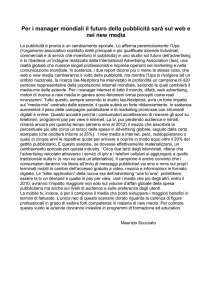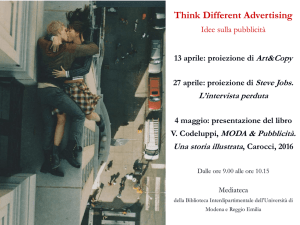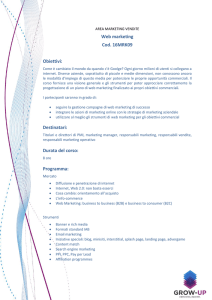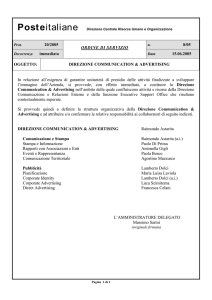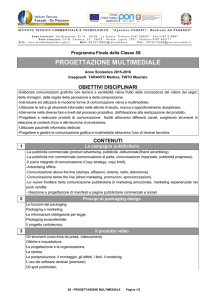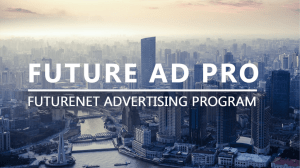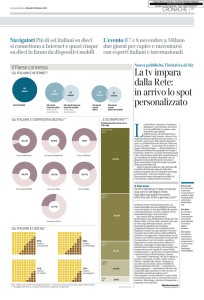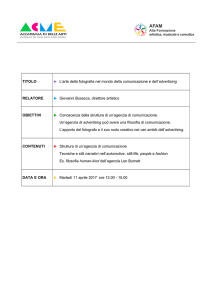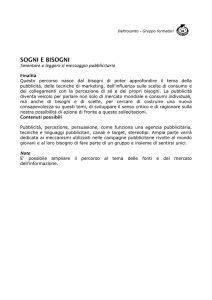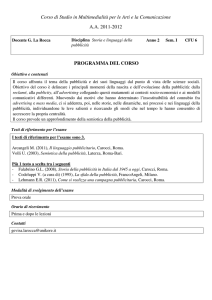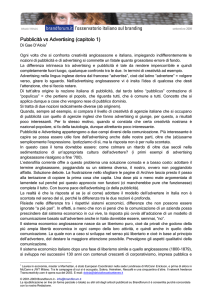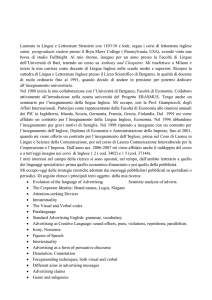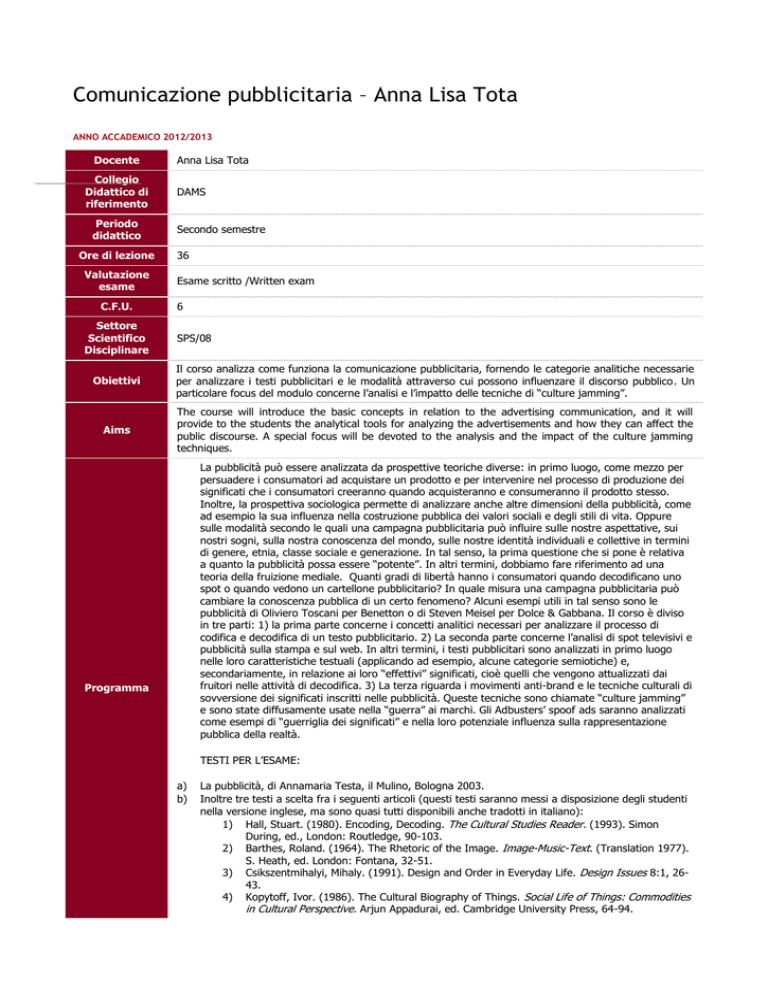
Comunicazione pubblicitaria – Anna Lisa Tota
ANNO ACCADEMICO 2012/2013
Docente
Collegio
Didattico di
riferimento
Periodo
didattico
Ore di lezione
Valutazione
esame
C.F.U.
Settore
Scientifico
Disciplinare
Anna Lisa Tota
DAMS
Secondo semestre
36
Esame scritto /Written exam
6
SPS/08
Obiettivi
Il corso analizza come funziona la comunicazione pubblicitaria, fornendo le categorie analitiche necessarie
per analizzare i testi pubblicitari e le modalità attraverso cui possono influenzare il discorso pubblico. Un
particolare focus del modulo concerne l’analisi e l’impatto delle tecniche di “culture jamming”.
Aims
The course will introduce the basic concepts in relation to the advertising communication, and it will
provide to the students the analytical tools for analyzing the advertisements and how they can affect the
public discourse. A special focus will be devoted to the analysis and the impact of the culture jamming
techniques.
La pubblicità può essere analizzata da prospettive teoriche diverse: in primo luogo, come mezzo per
persuadere i consumatori ad acquistare un prodotto e per intervenire nel processo di produzione dei
significati che i consumatori creeranno quando acquisteranno e consumeranno il prodotto stesso.
Inoltre, la prospettiva sociologica permette di analizzare anche altre dimensioni della pubblicità, come
ad esempio la sua influenza nella costruzione pubblica dei valori sociali e degli stili di vita. Oppure
sulle modalità secondo le quali una campagna pubblicitaria può influire sulle nostre aspettative, sui
nostri sogni, sulla nostra conoscenza del mondo, sulle nostre identità individuali e collettive in termini
di genere, etnia, classe sociale e generazione. In tal senso, la prima questione che si pone è relativa
a quanto la pubblicità possa essere “potente”. In altri termini, dobbiamo fare riferimento ad una
teoria della fruizione mediale. Quanti gradi di libertà hanno i consumatori quando decodificano uno
spot o quando vedono un cartellone pubblicitario? In quale misura una campagna pubblicitaria può
cambiare la conoscenza pubblica di un certo fenomeno? Alcuni esempi utili in tal senso sono le
pubblicità di Oliviero Toscani per Benetton o di Steven Meisel per Dolce & Gabbana. Il corso è diviso
in tre parti: 1) la prima parte concerne i concetti analitici necessari per analizzare il processo di
codifica e decodifica di un testo pubblicitario. 2) La seconda parte concerne l’analisi di spot televisivi e
pubblicità sulla stampa e sul web. In altri termini, i testi pubblicitari sono analizzati in primo luogo
nelle loro caratteristiche testuali (applicando ad esempio, alcune categorie semiotiche) e,
secondariamente, in relazione ai loro “effettivi” significati, cioè quelli che vengono attualizzati dai
fruitori nelle attività di decodifica. 3) La terza riguarda i movimenti anti-brand e le tecniche culturali di
sovversione dei significati inscritti nelle pubblicità. Queste tecniche sono chiamate “culture jamming”
e sono state diffusamente usate nella “guerra” ai marchi. Gli Adbusters’ spoof ads saranno analizzati
come esempi di “guerriglia dei significati” e nella loro potenziale influenza sulla rappresentazione
pubblica della realtà.
Programma
TESTI PER L’ESAME:
a)
b)
La pubblicità, di Annamaria Testa, il Mulino, Bologna 2003.
Inoltre tre testi a scelta fra i seguenti articoli (questi testi saranno messi a disposizione degli studenti
nella versione inglese, ma sono quasi tutti disponibili anche tradotti in italiano):
1) Hall, Stuart. (1980). Encoding, Decoding. The Cultural Studies Reader. (1993). Simon
During, ed., London: Routledge, 90-103.
2) Barthes, Roland. (1964). The Rhetoric of the Image. Image-Music-Text. (Translation 1977).
S. Heath, ed. London: Fontana, 32-51.
3) Csikszentmihalyi, Mihaly. (1991). Design and Order in Everyday Life. Design Issues 8:1, 2643.
4) Kopytoff, Ivor. (1986). The Cultural Biography of Things. Social Life of Things: Commodities
in Cultural Perspective. Arjun Appadurai, ed. Cambridge University Press, 64-94.
5)
6)
7)
Program
Kress, Gunther & van Leewuen, Theo. (1996). Modality: Designing Models of Reality.
Reading Images: The Grammar of Visual Design. London: Routledge, 154-174.
Kress, Gunther & van Leewuen, Theo. (1996). Representation and Interaction: Designing
the Position of the Viewer. Reading Images: The Grammar of Visual Design. London:
Routledge, 114-153.
Beasely, Ron & Danesi, Marcel. (2002). Creating Recognizability for the Product. Persuasive
Signs: The Semiotics of Advertising. Berlin, New York: Mouton de Gruyter, 49-93.
Advertising can be analysed from very different points of view and theoretical perspectives:
first of all, as a means to persuade consumers to buy a product, and to intervene in the
process of producing the meanings that the consumers will create when they will buy and
consume the product itself. However, the sociological perspective can investigate also
other dimensions of advertising, such as its impact on the public construction of social
values and ways of life, or on the ways in which an advertising campaign can shape our
expectations, dreams, knowledge of the world, individual and collective identities in
terms of gender, ethnicity, social class, and generations. In this respect, the first
question to be raised is related to how and what extent advertising can be powerful.
In other terms, we need to refer to a theory a communication, a sociological theory
of media audiences, a model of reception. How many degrees of freedom do the
consumers have when they are decoding a spot? And when they see an advertisement?
To which extent can an advertising campaign change the public understanding of a
certain phenomenon? Some useful examples to work with are the advertising campaigns
created by Oliviero Toscani for Benetton or by Steven Meisel for Dolce & Gabbana.
The course is divided in three parts: 1) the first part deals with the theoretical
concepts and models necessary to analyse the encoding and decoding processes
related to advertising. 2) The second part consists of the analysis of several TV spots
and advertisements, which will be considered both as texts and objects of decoding
activities. In other terms, advertisements and spots will be analysed firstly in their
textual main characteristics (by applying for example, some semiotic categories) and,
secondly, in relation to the “real” meanings that will emerge in the decoding activities
of the consumers. 3) The last part is focused
on anti-brand movements and analyse the cultural techniques of subverting the
meanings inscribed in advertisements. These techniques are called “culture jamming”
and have been extensively used in the war against the brands. The Adbusters’ spoof
ads will be analysed as examples of a “war of meanings” and in their potential impact
on the public representation of reality.
Syllabus:
a)
b)
La pubblicità, di Annamaria Testa, il Mulino, Bologna 2003.
Moreover, three texts selected among the following articles:
1) Hall, Stuart. (1980). Encoding, Decoding. The Cultural Studies Reader. (1993). Simon During, ed.,
London: Routledge, 90-103.
2) Barthes, Roland. (1964). The Rhetoric of the Image. Image-Music-Text. (Translation 1977). S.
Heath, ed. London: Fontana, 32-51.
3) Csikszentmihalyi, Mihaly. (1991). Design and Order in Everyday Life. Design Issues 8:1, 26-43.
4) Kopytoff, Ivor. (1986). The Cultural Biography of Things. Social Life of Things: Commodities in
Cultural Perspective. Arjun Appadurai, ed. Cambridge University Press, 64-94.
5) Kress, Gunther & van Leewuen, Theo. (1996). Modality: Designing Models of Reality. Reading
Images: The Grammar of Visual Design. London: Routledge, 154-174.
6) Kress, Gunther & van Leewuen, Theo. (1996). Representation and Interaction: Designing the
Position of the Viewer. Reading Images: The Grammar of Visual Design. London: Routledge,
114-153.
7) Beasely, Ron & Danesi, Marcel. (2002). Creating Recognizability for the Product. Persuasive
Signs: The Semiotics of Advertising. Berlin, New York: Mouton de Gruyter, 49-93.
Le slides del corso saranno pubblicate sulla pagina web del docente sul sito del Dipartimento di
Comunicazione e Spettacolo (www.dicospe.com).
Teaching
materials
Teaching materials will be published on the personal web page of the professor hosted on the website of
the Department of Communication and Entertainment (www.dicospe.uniroma3.it).
Sito web
http://www.dicospe.uniroma3.it

